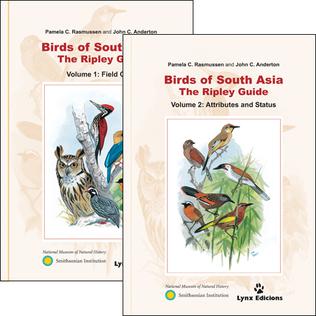
The true finches are small to medium-sized passerine birds in the family Fringillidae. Finches generally have stout conical bills adapted for eating seeds and nuts and often have colourful plumage. They occupy a great range of habitats where they are usually resident and do not migrate. They have a worldwide native distribution except for Australia and the polar regions. The family Fringillidae contains more than two hundred species divided into fifty genera. It includes the canaries, siskins, redpolls, serins, grosbeaks and euphonias, as well as the morphologically divergent Hawaiian honeycreepers.

The rosefinches are a genus, Carpodacus, of passerine birds in the finch family Fringillidae. Most are called "rosefinches" and as the word implies, have various shades of red in their plumage. The common rosefinch is frequently called the "rosefinch". The genus name is from the Ancient Greek terms karpos, "fruit", and dakno, "to bite".

The common rosefinch or scarlet rosefinch is the most widespread and common rosefinch of Asia and Europe.

Edward Blyth was an English zoologist who worked for most of his life in India as a curator of zoology at the Royal Asiatic Society of Bengal in Calcutta.

The bird family Casuariidae has four surviving members: the three species of cassowary and the emu.

Przevalski's finch, Przewalski's finch or Przevalski's pinktail, is an unusual passerine bird endemic to the mountains of central-west China. The species is named after Mikhail Pyltsov, the Russian explorer who accompanied Nikolai Przhevalsky on the expedition in which specimens of the bird were collected. Its taxonomic affinities were unclear for a long time, giving rise to other common names, the pink-tailed bunting and the Przewalski's rosefinch. In 2000 it was proposed that it should in fact be regarded neither as a finch nor a bunting, but as the only member of the family Urocynchramidae, something that had been originally proposed in the German ornithological literature as long ago as 1918 by Janusz von Domaniewski, and also by Wolters in 1979. This change was adopted in the sixth edition of the Clements checklist.

The dark-breasted rosefinch is a species of true finch in the monotypic genus Procarduelis. It is found in Bhutan, China, India, Laos, Myanmar, Nepal, Pakistan, Thailand, and Vietnam. Its natural habitats are boreal forests and subtropical or tropical high-altitude shrubland.

The Tibetan rosefinch, also known as Roborovski's rosefinch, is a species of rosefinch in the finch family Fringillidae. It is sometimes placed in the monotypic genus Kozlowia. It is endemic to the Tibetan Plateau. Its natural habitat is montane tundra.

The pink-browed rosefinch is a finch in the family Fringillidae. Nicholas Aylward Vigors first described the species in 1831. It is migratory and ranges across the northern regions of the Indian subcontinent, mainly in the Himalayas. It is found in Bhutan, Tibet, India, Nepal, and Pakistan. Its natural habitats are boreal forests, shrub-lands, grasslands, and dry forests.

Pallas's rosefinch is a species of bird in the finch family Fringillidae. It is found in China, Japan, Kazakhstan, Korea, Mongolia, and Russia. Birds are occasionally reported from further west and there are records from several European regions, including Britain, but the cage-bird trade makes the origin of some such birds hard to assess. Its natural habitats are boreal forests and boreal shrubland.

Blanford's rosefinch or the crimson rosefinch, is a species of finch in the family Fringillidae. It is found in Bhutan, China, India, and Nepal. Its natural habitat is boreal forest.

The great rosefinch is a species of finch in the family Fringillidae. It is found in Afghanistan, Armenia, Azerbaijan, Georgia, Iran, Kazakhstan, Kyrgyzstan, Mongolia, Pakistan, Russia, Tajikistan, and Uzbekistan and east to China. Its natural habitats are tundra and temperate grassland.

The scarlet finch is a small passerine bird in the finch family Fringillidae. It is found in the Himalayas from Uttarakhand state in the Indian Himalayas eastwards across Nepal, stretching further east to the adjacent hills of Northeast India and Southeast Asia as far south as Thailand. It is resident in the Himalayas, but many birds winter to the immediate south. Its natural habitat is temperate forests.

The crimson-browed finch is a true finch species. It is found in Bhutan, China, India, Myanmar, and Nepal. Its natural habitats are temperate forests and temperate shrubland.

The Siberian long-tailed rosefinch is a species of finch of the family Fringillidae.

Cyornis is a genus of birds in the Old World flycatcher family Muscicapidae most of which are native to Southeast Asia.

Birds of South Asia: The Ripley Guide by Pamela C. Rasmussen and John C. Anderton is a two-volume ornithological handbook, covering the birds of South Asia, published in 2005 by the Smithsonian Institution and Lynx Edicions. The geographical scope of the book covers India, Bangladesh, Pakistan, Sri Lanka, Nepal, Bhutan, Maldives, the Chagos Archipelago and Afghanistan. In total, 1508 species are covered. Two notable aspects of Birds of South Asia are its distribution evidence-base — the book's authors based their distributional information almost completely on museum specimens — and its taxonomic approach, involving a large number of species-level splits.
The Chinese beautiful rosefinch is a true finch species. It is one of the rosefinches that might belong in the genus Propasser. It is found in China and Mongolia. Its natural habitats are temperate shrubland and subtropical or tropical high-altitude shrubland.

The white-browed shrike-babbler is a bird species found in the eastern Himalayas and Southeast Asia from northern Burma to southern Cambodia. Like others in the genus it is found in montane forests. Males and females have different plumages and variations occur through its range with several populations being treated as subspecies. It is part of a cryptic species complex and was earlier lumped as a subspecies of the white-browed shrike-babbler. Clements lumps this bird into the white-browed shrike-babbler.

















